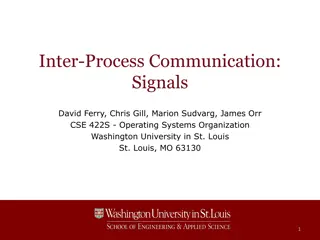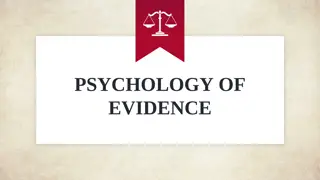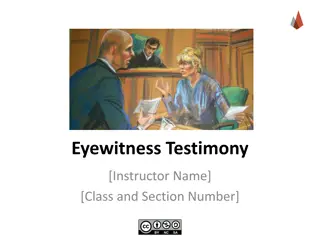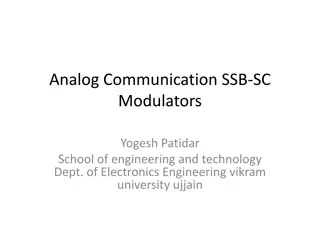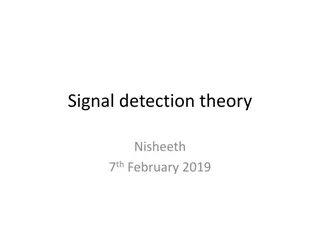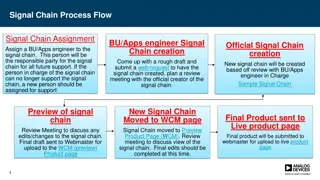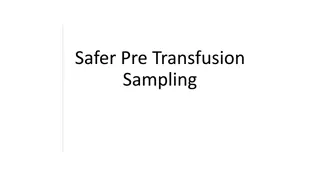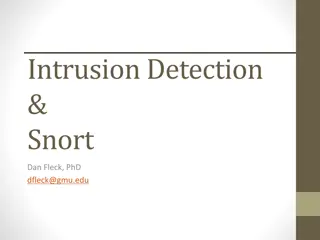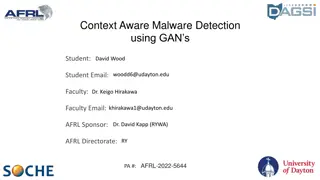Eyewitness Misidentification and Signal Detection Theory
Eyewitness misidentifications have been a key factor in wrongful convictions, with high confidence leading to erroneous identifications. The case of Ronald Cotton exemplifies the impact of misidentification, prompting the need for reliable identification procedures such as sequential lineups based on signal detection theory. This theory applies in scenarios where there are two true states of the world and imperfect diagnostic procedures are present, as seen in various real-life situations from identifying enemy planes to guilty suspects in a lineup.
Download Presentation

Please find below an Image/Link to download the presentation.
The content on the website is provided AS IS for your information and personal use only. It may not be sold, licensed, or shared on other websites without obtaining consent from the author.If you encounter any issues during the download, it is possible that the publisher has removed the file from their server.
You are allowed to download the files provided on this website for personal or commercial use, subject to the condition that they are used lawfully. All files are the property of their respective owners.
The content on the website is provided AS IS for your information and personal use only. It may not be sold, licensed, or shared on other websites without obtaining consent from the author.
E N D
Presentation Transcript
SIGNAL-DETECTION THEORY AND RECEIVER OPERATING CHARACTERISTIC (ROC) ANALYSIS Psych 272
Eyewitness Memory and Wrongful Convictions Since the 1990s, DNA testing has overturned 318 wrongful convictions Eyewitness misidentifications which were invariably made with high confidence in a court of law played a role in 75% of these cases One of the most famous cases involved the misidentification of a man named Ronald Cotton
The Case of Ronald Cotton In 1984, a college student named Jennifer Thompson was raped Shortly thereafter, she picked Ronald Cotton out of a photo lineup "I was absolutely, positively, without-a-doubt certain he was the man who raped me when I got on that witness stand and testified against him. And nobody was going to tell me any different." Cotton was sentenced to life in prison plus 54 years, and he served almost 11 years in jail before being exonerated by DNA testing
Eyewitness Identification Procedures Simultaneous Lineup Suspect: Innocent or Guilty? Fillers: All are known to be innocent
Eyewitness Identification Procedures Simultaneous Lineup Sequential Lineup Suspect: Innocent or Guilty?
Lindsay & Wells (1985) Simultaneous lineup Correct ID rate = 0.58 False ID rate = 0.43 .58 / .43 = 1.35 Diagnosticity Ratio Sequential lineup Correct ID rate = 0.50 False ID rate = 0.17 .50 / .17 = 2.94
When does signal detection theory apply? 1. There are two true states of the world An enemy plane is either present or absent in the sky A disease is either present or absent in a patient A guilty suspect is either present or absent in a lineup 2. An imperfect diagnostic procedure is used to make a decision (the target is "present" or "absent") An air-defense radar system A medical test An eyewitness presented with a lineup
2 X 2 Table Diagnostic Decision Absent Present Hit Miss Present (Correct ID) True State Correct Rejection False Alarm (False ID) Absent
2 X 2 Table Diagnostic Decision Absent Present Hit Miss Present (Correct ID) True State Correct Rejection False Alarm (False ID) Absent
2 X 2 Table Diagnostic Decision Absent Present Hit Miss Present (Correct ID) True State Correct Rejection False Alarm (False ID) Absent
2 X 2 Table Diagnostic Decision Absent Present Hit Miss Present (Correct ID) True State Correct Rejection False Alarm (False ID) Absent
2 X 2 Table Diagnostic Decision Absent Present Hit Miss Present (Correct ID) True State Correct Rejection False Alarm (False ID) Absent
2 X 2 Table Diagnostic Decision Absent Present Hit Miss Present (Correct ID) True State Correct Rejection False Alarm (False ID) Absent
2 X 2 Table Ted Bundy Diagnostic Decision Absent Present Hit Miss Present (Correct ID) True State Correct Rejection False Alarm (False ID) Absent Innocence Project Ronald Cotton
2 X 2 Table Ted Bundy Diagnostic Decision Absent Present Hit Miss Present (Correct ID) True State Correct Rejection False Alarm (False ID) Absent Innocence Project Ronald Cotton
2 X 2 Table Diagnostic Decision Absent Present Hit Miss Present (Correct ID) True State Correct Rejection False Alarm (False ID) Absent
Signal Detection Theory Continuous diagnostic signal Weak Signal Strong Signal Power of the reflected radio signal Blood glucose level Memory strength
Signal Detection Theory: Response Bias the guilty suspect is probably in the lineup Weak Signal Strong Signal
Signal Detection Theory: Response Bias the guilty suspect is probably in the lineup absent present Weak Signal Strong Signal Liberal response bias: Identify even if confidence is low
Signal Detection Theory: Response Bias the guilty suspect may or may not be in the lineup Weak Signal Strong Signal
Signal Detection Theory: Response Bias the guilty suspect may or may not be in the lineup absent present Weak Signal Strong Signal Neutral response bias: Identify if confidence is fairly high
Signal Detection Theory: Response Bias too many innocent suspects have been misidentified Weak Signal Strong Signal
Signal Detection Theory: Response Bias too many innocent suspects have been misidentified absent present Weak Signal Strong Signal Conservative response bias: Identify only if confidence is very high
Signal Detection Theory: Discriminability Weak Signal Strong Signal
Signal Detection Theory: Discriminability Target Absent (Innocent suspects) Weak Signal Strong Signal
Signal Detection Theory: Discriminability Target Absent (Innocent suspects) Weak Signal Strong Signal
Signal Detection Theory: Discriminability Target Absent (Innocent suspects) Target Present (Guilty suspects) Weak Signal Strong Signal
Signal Detection Theory: Discriminability The degree to which the memory signals associated with innocent and guilty suspects are separated using a particular diagnostic procedure Discriminability Target Absent (Innocent suspects) Target Present (Guilty suspects) Weak Signal Strong Signal
"Absent" "Present" Target Absent Liberal Target Present Weak Signal Strong Signal "Absent" "Present" Target Absent Neutral Target Present Weak Signal Strong Signal "Absent" "Present" Target Absent Conservative Target Present Weak Signal Strong Signal
"Absent" "Present" Target Absent Liberal: the guilty suspect is probably in the lineup Target Present Weak Signal Strong Signal "Absent" "Present" Target Absent Target Present Weak Signal Strong Signal "Absent" "Present" Target Absent Target Present Weak Signal Strong Signal
"Absent" "Present" Target Absent Correct ID Rate = 0.98 Liberal: the guilty suspect is probably in the lineup Target Present Weak Signal Strong Signal "Absent" "Present" Target Absent Target Present Weak Signal Strong Signal "Absent" "Present" Target Absent Target Present Weak Signal Strong Signal
"Absent" "Present" Target Absent Correct ID Rate = 0.98 Liberal: the guilty suspect is probably in the lineup Target Present False ID Rate = 0.50 Weak Signal Strong Signal "Absent" "Present" Target Absent Target Present Weak Signal Strong Signal "Absent" "Present" Target Absent Target Present Weak Signal Strong Signal
"Absent" "Present" Target Absent Target Present Weak Signal Strong Signal "Absent" "Present" Target Absent Neutral: the guilty suspect may or may not be the lineup Target Present Weak Signal Strong Signal "Absent" "Present" Target Absent Target Present Weak Signal Strong Signal
"Absent" "Present" Target Absent Target Present Weak Signal Strong Signal "Absent" "Present" Target Absent Correct ID Rate = 0.84 Neutral: the guilty suspect may or may not be the lineup Target Present Weak Signal Strong Signal "Absent" "Present" Target Absent Target Present Weak Signal Strong Signal
"Absent" "Present" Target Absent Target Present Weak Signal Strong Signal "Absent" "Present" Target Absent Correct ID Rate = 0.84 Neutral: the guilty suspect may or may not be the lineup Target Present False ID Rate = 0.16 Weak Signal Strong Signal "Absent" "Present" Target Absent Target Present Weak Signal Strong Signal
"Absent" "Present" Target Absent Target Present Weak Signal Strong Signal "Absent" "Present" Target Absent Target Present Weak Signal Strong Signal "Absent" "Present" Target Absent Conservative: do not make an ID unless you are certain of being correct Target Present Weak Signal Strong Signal
"Absent" "Present" Target Absent Target Present Weak Signal Strong Signal "Absent" "Present" Target Absent Target Present Weak Signal Strong Signal "Absent" "Present" Correct ID Rate = 0.50 Target Absent Conservative: do not make an ID unless you are certain of being correct Target Present Weak Signal Strong Signal
"Absent" "Present" Target Absent Target Present Weak Signal Strong Signal "Absent" "Present" Target Absent Target Present Weak Signal Strong Signal "Absent" "Present" Correct ID Rate = 0.50 Target Absent Conservative: do not make an ID unless you are certain of being correct Target Present False ID Rate = 0.02 Weak Signal Strong Signal
"Absent" "Present" Correct ID Rate = 0.98 Target Absent Target Present False ID Rate = 0.50 Receiver Operating Characteristic (ROC) Weak Signal Strong Signal 1.0 0.8 Correct ID Rate "Absent" "Present" 0.6 Target Absent Target Present Correct ID Rate = 0.84 0.4 False ID Rate = 0.16 0.2 Weak Signal Strong Signal 0.0 0.0 0.2 0.4 0.6 0.8 1.0 False ID Rate "Absent" "Present" Correct ID Rate = 0.50 Target Absent Target Present False ID Rate = 0.02 Weak Signal Strong Signal
Receiver Operating Characteristic Analysis 1.0 0.8 Correct ID Rate High Target Absent 0.6 Target Present discriminability 0.4 0.2 Weak Signal Strong Signal 0.0 0.0 0.2 0.4 0.6 0.8 1.0 False ID Rate 1.0 0.8 Correct ID Rate Low 0.6 Target Absent discriminability Target Present 0.4 0.2 0.0 Weak Signal Strong Signal 0.0 0.2 0.4 0.6 0.8 1.0 False ID Rate




